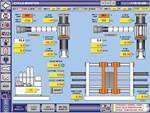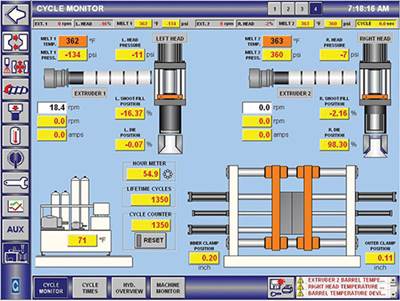Shutdown Tips For Accumulator Heads
Blow Molding Know How
Here's what you need to know to properly shutdown an accumulator head blow molding machine after a week running parts.
In our last column, we talked about how to properly restart accumulator-head machines after a weekend shutdown. Now let’s get into shutting them down the right way on Friday night. Here are some of the issues plant managers need to take into account:
•Machine conditions: Will the barrel/screw be left full of material or drained? This will depend on the plastic materials in use—such as color, whether or not the material is hygroscopic, or if it is susceptible to degradation.
If you’re running with a grooved-feed extruder, empty the feed section to avoid locking up the material when you start up next. The feed throat is usually drained on smooth-bore extruders as well, but this is not as critical as with a grooved extruder.
•Heats: on or off?: The decision here depends on a lot of factors, including the material currently in use, the material for the next startup, plant rules and regulations, and whether you have lights-out or attended shutdown.
If the heat is left at the run setting, you’ll need little or no reheat time on startup. On the other hand, there will be a higher likelihood of degraded material (brown specs) upon restart.
Heats banked to a lower setting are best for short-term shutdowns for maintenance or changeover. Turning the heat off altogether is the safest and probably most energy-efficient approach. And you’re less likely to have severe material degradation in the barrel and head(s). But it will require a longer reheat time on startup.
•Material considerations: Is a material change required at restart? A material change at shutdown can make startup less stressful.
Is there a color change needed for the restart? If so, does it make sense to change to the next color at shutdown? If so, then during restart, the color change can be completed while the machine is reaching steady-state run conditions, minimizing production time loss. Or does it make more sense to introduce natural material during shutdown to minimize color-change time? That may be the case if the color-change direction is not clear at shutdown.
Does the material require drying? If so, drain the machine hopper and load the material into the dryer so there will be no wait time for dry material on startup.
If you’re starting up on the same material and blend, close the slide gate and empty the feed section of the extruder to minimize feed issues upon restarting.
•Auxiliary equipment: Are conveyors, grinders, cyclones, hoppers, and bins shut down and left in a fully ready state? Are chillers/tower systems in the correct mode and state to follow the shutdown, as well as ready for the restart? If heats are left on, is the chilled-water/tower system required to support the machine? If heats are set to initialize automatically, is the chilled water or tower set to support the equipment?
Are mold-temperature control units properly shut down and ready for startup? Are the correct valves on/off for the shutdown?
The blenders and material conveying systems need to be shut down and readied for the next startup. Are the blender filters cleaned? Is the blower for material conveyance turned off?
•Mold/press considerations: Should molds be left open or closed? Open molds may require mold-protection spray. Do mold vents require cleaning? Do leader pins and bushings require lubrication? Would leaving molds closed avoid possible mold corrosion or damage? If there will be machine maintenance performed nearby, closing the mold might be prudent to avoid mold damage. (It’s a good idea to check the press for any items needing maintenance during shutdown.)
•Sequencing: Proper sequencing of the machine shutdown can influence both the shutdown and the restart. Material flow to the machine should be shut off prior to actual shutdown to empty or prepare hopper(s) and blender. Ensure that all materials are processed through conveyors and grinder systems prior to switching them off.
Allow molds to cool, but not too much (to avoid condensation or mold sweating) before switching off mold cooling. Allow hydraulics and other systems to cool before switching off general machine cooling.
Consider restart requirements/conditions. Turn off the air supply. Drain condensate from the air receiver, if applicable. Save recipes as needed to avoid loss of data, and preserve recent process changes.Clean around the heads, extruder, and press, as well as other machine areas to prepare for restart. Consider performing weekly/daily maintenance to reduce startup time. Check lubrication and/or oil levels of the press or heads. Clean the air, hydraulic, and water filters. Clean out air separators.
Perform a visual machine check to verify that all systems and components are correctly shut down and ready for restart.
These guidelines will be different for specific machines, materials, and conditions. Checklists are a great way for shutdowns to be completed in a repeatable and efficient manner.
EDITOR’S NOTE: The author acknowledges Steve Griffiths’ contribution to this article. Griffiths has 17 years of hands-on experience with industrial accumulator head machines. He is currently senior process/service technician for Graham Engineering Corp. He has been involved with hundreds of machine startups and troubleshooting over the years. Contact: (717) 891-3852; email: sgriffiths@grahamengineering.com
Related Content
How to Select the Right Cooling Stack for Sheet
First, remember there is no universal cooling-roll stack. And be sure to take into account the specific heat of the polymer you are processing.
Read MoreBack to Basics on Mold Venting (Part 2: Shape, Dimensions, Details)
Here’s how to get the most out of your stationary mold vents.
Read MoreThe Effects of Stress on Polymers
Previously we have discussed the effects of temperature and time on the long-term behavior of polymers. Now let's take a look at stress.
Read MoreWhere and How to Vent Injection Molds: Part 3
Questioning several “rules of thumb” about venting injection molds.
Read MoreRead Next
Monday Morning Start-Up Of Accumulator Head Machines
A good way to achieve plantwide consistency on restarts is to establish a blow molding checklist based on the items discussed here, as different operators may be performing these steps at various times.
Read MoreLead the Conversation, Change the Conversation
Coverage of single-use plastics can be both misleading and demoralizing. Here are 10 tips for changing the perception of the plastics industry at your company and in your community.
Read MoreFor PLASTICS' CEO Seaholm, NPE to Shine Light on Sustainability Successes
With advocacy, communication and sustainability as three main pillars, Seaholm leads a trade association to NPE that ‘is more active today than we have ever been.’
Read More






















